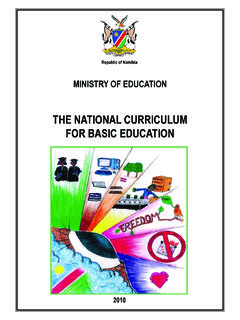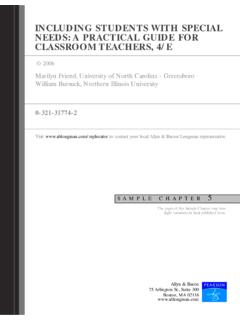Transcription of Encouraging Quality in Early Childhood Education …
1 1 Encouraging Quality in Early Childhood Education and Care (ECEC) RESEARCH BRIEF: curriculum MATTERS What is curriculum ? curriculum refers to the contents and methods that substantiate children s learning and development. It answers the questions what to teach? and how to teach it? (NIEER, 2007). It is a complex concept especially in ECEC, containing multiple components, such as ECEC goals, content and pedagogical practices (Litjens and Taguma, 2010). What is at stake? There is growing consensus on the importance of an explicit curriculum with clear purpose, goals and approaches for zero-to-school-age children (Bertrand, 2007). Most OECD countries now use a curriculum in Early Childhood services, especially as children grow older, that is to say, that some structuring and orientation of children s experience towards educational aims is generally accepted.
2 Currently, there is little pedagogical direction for younger children, although many neurological developments take place prior to age of three or four (OECD, 2006). Curricula are influenced by many factors, including society s values, content standards, research findings, community expectations, culture and language. Although these factors differ per country, state, region and even programme, high- Quality , well-implemented ECEC curricula provide developmentally appropriate support and cognitive challenges that can lead to positive child outcomes (Frede, 1998). With trends toward decentralisation and diversification of policy and provision, there is more variation in programming and Quality at the local level. A common framework can help ensure an even level of Quality across different forms of provision and for different groups of children, while allowing for adaptation to local needs and circumstances.
3 A clear view and articulation of goals, whether in the health, nutrition or Education field, can help foster programmes that will promote the well-being of young children and respond adequately to children s needs (OECD, 2006). Well-defined educational projects also serve the interests of young children. In infant-toddler settings with a weak pedagogical framework, young children may miss out on stimulating environments that are of high importance in the Early years. At the programme level, guidelines for practice in the form of a pedagogical or curriculum framework help staff to clarify their pedagogical aims, keep progression in mind, provide a structure for the child s day, and focus observation on the most important aspects of child development (Siraj-Blatchford, 2004).
4 Debate remains widespread over the correct curriculum approach for the youngest and older children in ECEC. This raises important questions about aspects, such as the scope, relevance, focus and age-appropriateness of content; depth and length of descriptions; and input- or outcome-based descriptions. The learning areas that receive most focus in official curricula particularly in countries where child assessments are used shortly after entry into primary school are literacy and numeracyCountries in the social pedagogy tradition do not exclude emergent literacy and numeracy but seek to maintain an open and holistic curriculum until children enter school and, sometimes, well into the Early classes of primary school. On the other hand, countries in which Early Education has been part of, or closely associated with, primary school tend to privilege readiness for school and a more academic approach to curriculum and methodology.
5 2 Why does it matter? Consistency and adaptation to local needs A common ECEC curriculum can have multiple benefits. It can ensure more even Quality levels across provisions and age groups, contributing to a more equitable system. It can also guide and support staff; facilitate communication between teachers and parents; and ensure continuity between pre-primary and primary school levels. However, a curriculum can remain unchanged for years and lack the necessary innovation to adapt to ever-changing knowledge societies. It can equally limit the freedom and creativity of ECEC staff (OECD, 2006). Because ECEC centres are becoming more culturally diverse with children from different backgrounds and home environments, acknowledging that these children might have different needs is important for the effectiveness of a programme.
6 Settings and activities that are designed to accommodate young children s different approaches to learning have been found to reduce disruptive and inattentive behaviour, like fighting with peers and unwillingness to respond to questions or co-operate in class (Philips et al., 2000). The wide range of cultures, communities and settings in which young children grow up makes it essential to engage different stakeholders in developing and refining curricula and to adapt curricula, when needed, to local or cultural circumstances. This is to ensure that curricula actually meet children s needs and truly focus on the child and their development (NAEYC, 2002). Balancing diverse expectations It is important that all stakeholders agree on the contents of the pre-primary curriculum .
7 Governments and parents may share common objectives such as preparing children for school; but they may also disagree on the appropriateness of specific pre-primary subjects for children, such as the integration of ICT in the classroom. In multicultural societies, governments may want to create a skilled and knowledgeable workforce and prioritise shared values for building a sense of community. Meanwhile, minority group families may be more concerned with transmitting native languages and customs to children while respecting specific beliefs on child rearing. Curricula can contribute to balancing different expectations of Early Childhood development in the curriculum and ensure that expectations and needs of different stakeholders are met (Bennett, 2011; Siraj-Blatchford and Woodhead, 2009; Vandenbroeck, 2011).
8 Provides guidance, purpose and continuity curriculum can provide clear guidance and purpose through explicit pedagogical guidelines. A focused curriculum with clear goals helps ensure that ECEC staff cover critical learning or development areas. It can therefore equip children with the knowledge and skills needed for primary school and further learning and facilitate smooth transitions between Education levels (UNESCO, 2004). Improves Quality and reinforces impact curriculum can establish higher and more consistent Quality across varied ECEC provisions; and having a steering curriculum is found to contribute to decreased class repetition, reduced referral to special Education and better transitions to primary school (Eurydice, 2009). At the same time, a high- Quality curriculum can reduce the fade-out effect of knowledge gained in preschool (Pianta et al.)
9 , 2009). Facilitates the involvement of parents curriculum can inform parents about what their children are learning in an Education or care setting. It can act as a bridge between ECEC staff and parents for information sharing and needs-based interventions. Parental knowledge of the curriculum can be particularly important for children with special needs or learning difficulties to provide added support at home. One of the most effective approaches to increasing 3 children s later achievement and adjustment is to support parents in actively engaging with children s learning activities at home (Desforges and Abouchaar, 2003; Harris and Goodall 2006). Activities that can be beneficially promoted include reading to children, singing songs and nursery rhymes, going to the library and playing with numbers.
10 What aspect matters most? Thinking beyond curriculum dichotomies Traditionally, ECEC curricula have been categorised into academic and more comprehensive models. An academic approach makes use of a staff-initiated curriculum with cognitive aims for school preparation. A comprehensive approach centres on the child and seeks to broaden the scope for holistic development and well-being (Bertrand, 2007; OECD, 2006). An academic approach can prescribe teaching in critical subject areas but can also limit a child-centred environment characterised by self-initiated activity, creativity and self-determination (Eurydice, 2009; Prentice, 2000). With more flexible aims, a comprehensive approach can better integrate social and emotional well-being, general knowledge and communication skills but risks losing focus of important Education goals, as can be seen in Table 1 (Pianta, 2010; Bertrand, 2007; UNESCO, 2004).
















